Petrogenesis and Geodynamic Significance of the Early Triassic Nanpo Adakitic Pluton of the Luang Prabang-Loei Tectonic Belt (Northwestern Laos) in the East Tethys Domain: Constraints from Zircon U-Pb-Hf Isotope Analyses and Whole-Rock Geochemistry
Abstract
1. Introduction
2. Regional Geological Background
3. Sample and Petrographic Characteristics
4. Analytical Methods
4.1. Whole-Rock Geochemistry
4.2. Zircon U-Pb Dating
4.3. Zircon Lu-Hf Isotopes
5. Results
5.1. Whole-Rock Geochemistry
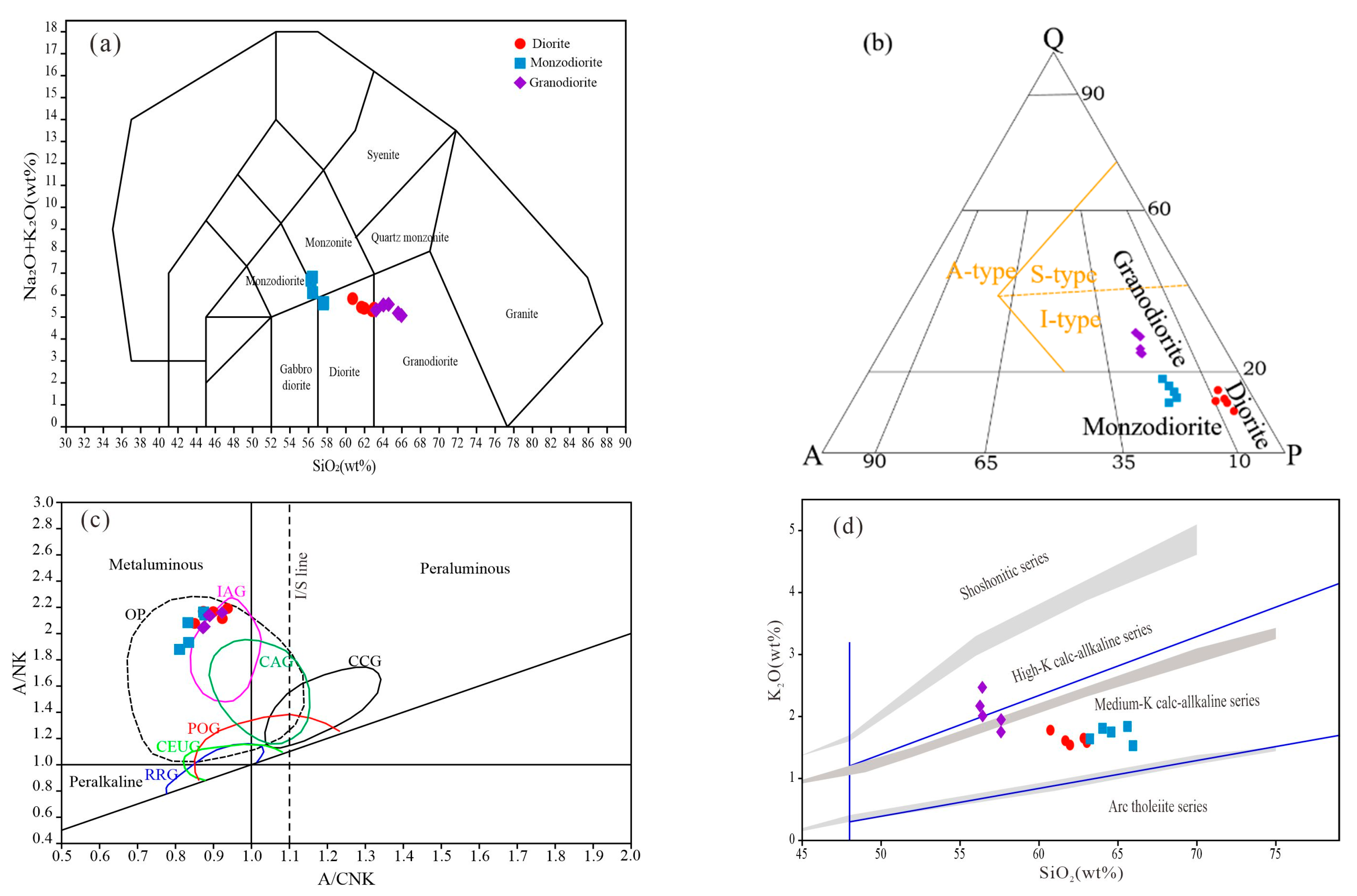
5.2. Zircon U-Pb Dating
5.3. Zircon Lu-Hf Isotopes
6. Discussion
6.1. Petrogenesis
6.2. Tectonic Background and Geological Significance
7. Conclusions
- (1)
- LA-ICP-MS zircon U-Pb geochronology documents the Early Triassic formation age (247–249 Ma) of the Nanpo adakites in Laos. Their composition is characterized by high Si, Al, Na, and Sr contents, low K, Mg, and Y contents, and intermediate Mg# values (42–50) that are typical for adakitic rocks.
- (2)
- Petrology, geochemistry, and zircon Lu-Hf isotopes indicate that the parental melts of the Nanpo adakites were derived from the partial melting of the thickened lower crust in the plate fault environment, and the mantle-derived magma participated in the magmatic evolution process.
- (3)
- Our study shows that the generation of Early Triassic adakite magmatism in the Luang Prabang-Loei tectonic belt may have been a response to the tectonic transition from oceanic subduction to post-subduction extension. The transformation of the ancient continental crust and the subsequent crust–mantle magma mixing are the main mechanisms for the growth of continental crust in the Paleo-Tethys orogenic belt in Southeast Asia.
- (4)
- The Luang Prabang-Loei Paleo-Tethys ocean basin closed in the Late Permian–Early Triassic, and then the Sibumasu block collided with the Indochina block in the Middle-Late Triassic.
Supplementary Materials
Author Contributions
Funding
Data Availability Statement
Acknowledgments
Conflicts of Interest
References
- Goldfarb, R.J.; Taylor, R.D.; Collins, G.S.; Goryachev, N.A.; Orlandini, O.F. Phanerozoic continental growth and gold metallogeny of Asia. Gondwana Res. 2014, 25, 48–102. [Google Scholar] [CrossRef]
- Qian, X.; Feng, Q.; Wang, Y.; Chonglakmani, C.; Monjai, D. Geochronological and geochemical constraints on the mafic rocks along the Luang Prabang zone: Carboniferous back-arc setting in northwest Laos. Lithos 2016, 245, 60–75. [Google Scholar] [CrossRef]
- Qian, X.; Feng, Q.; Yang, W.; Wang, Y.; Chonglakmani, C.; Monjai, D. Arc-like volcanic rocks in NW Laos: Geochronological and geochemical constraints and their tectonic implications. J. Asian Earth Sci. 2015, 98, 342–357. [Google Scholar] [CrossRef]
- Shusheng, L.; Yongfei, Y.; Linnan, G.; Zhimin, P.; Guitang, P. Tectonic characteristics and metallogeny in Southeast Asia. Geol. China 2018, 45, 863–889, (In Chinese with English abstract). [Google Scholar]
- Deng, J.; Wang, Q. Gold mineralization in China: Metallogenic provinces, deposit types and tectonic framework. Gondwana Res. 2016, 36, 219–274. [Google Scholar] [CrossRef]
- Gan, J.; Li, H.; He, Z.; Gan, Y.; Mu, J.; Liu, H.; Wang, L. Application and Significance of Geological, Geochemical, and Geophysical Methods in the Nanpo Gold Field in Laos. Minerals 2022, 12, 96. [Google Scholar] [CrossRef]
- Goldfarb, R.J.; Baker, T.; Dubé, B.; Groves, D.I.; Gosselin, P. Distribution, Character, and Genesis of Gold Deposits in Metamorphic Terranes. In One Hundredth Anniversary Volume; Society of Economic Geologists: Tucson, AZ, USA, 2005. [Google Scholar]
- Guo, L.; Hou, L.; Liu, S.; Nie, F. Rare Earth Elements Geochemistry and C–O Isotope Characteristics of Hydrothermal Calcites: Implications for Fluid-Rock Reaction and Ore-Forming Processes in the Phapon Gold Deposit, NW Laos. Minerals 2018, 8, 438. [Google Scholar] [CrossRef]
- Hou, L.; Xiong, F.; Wang, W.; Guo, L.; Peng, H.; Ni, S.; Zhang, Q. Carboniferous-Triassic felsic igneous rocks and typical mineral deposits in the Truong Son orogenic belt, SE Asia: Implications for Paleo-Tethyan tectonic evolution and metallogeny. Ore Geol. Rev. 2019, 112, 103036. [Google Scholar] [CrossRef]
- Han, S.; Wang, S.; Tang, Z.; Tan, K.; Duan, X.; He, H.; Feng, Z.; Xie, Y. Integrated geophysical exploration of the coupling of a concealed rock body and metallogenic structures—Ag-Pb-Zn mining area case study in Jilinbaolige, Inner Mongolia, China. J. Appl. Geophys. 2020, 178, 104048. [Google Scholar] [CrossRef]
- Shi, M.; Khin, Z.; Liu, S.; Xu, B.; Meffre, S.; Cong, F.; Nie, F.; Peng, Z.; Wu, Z. Geochronology and petrogenesis of Carboniferous and Triassic volcanic rocks in NW Laos: Implications for the tectonic evolution of the Loei Fold Belt. J. Asian Earth Sci. 2021, 208, 104661. [Google Scholar] [CrossRef]
- Zaw, K.; Meffre, S.; Lai, C.; Burrett, C.; Santosh, M.; Graham, I.; Manaka, T.; Salam, A.; Kamvong, T.; Cromie, P. Tectonics and metallogeny of mainland Southeast Asia—A review and contribution. Gondwana Res. 2014, 26, 5–30. [Google Scholar]
- Qian, X.; Li, H.; Yu, X.; Zhang, Y.; Wang, Y. Permian-Triassic Magmatism Along the Truong Son Zone in SE Asia and its Paleotethyan Tectonic Implications. Geotectonic. Metallogeni. 2022, 46, 585–604, (In Chinese with English abstract). [Google Scholar]
- Metcalfe, I. Gondwana dispersion and Asian accretion: Tectonic and palaeogeographic evolution of eastern Tethys. J. Asian Earth Sci. 2013, 66, 1–33. [Google Scholar] [CrossRef]
- Metcalfe, I.; Crowley, J.L. Upper Permian and Lower Triassic conodonts, high-precision U-Pb zircon ages and the Permian-Triassic boundary in the Malay Peninsula. J. Asian Earth Sci. 2020, 199, 104403. [Google Scholar] [CrossRef]
- Sone, M.; Metcalfe, I.; Chaodumrong, P. The Chanthaburi terrane of southeastern Thailand: Stratigraphic confirmation as a disrupted segment of the Sukhothai Arc. J. Asian Earth Sci. 2012, 61, 16–32. [Google Scholar] [CrossRef]
- Wang, H.; Lin, F.; Li, X.; Shi, M. The division of tectonic units and tectonic evolution in Laos and its adjacent regions. Geol. China 2015, 42, 71–84, (In Chinese with English abstract). [Google Scholar]
- Shifeng, W.; Yasi, M.; Chao, W.; Peisheng, Y. Paleotethyan evolution of the Indochina Block as deduced from granites in northern Laos. Gondwana Res. 2016, 38, 183–196. [Google Scholar]
- Xu, W.; Liu, F.; Xu, W.; Wang, H.; Ji, L.; Wang, F.; Wang, D. Geochemical and Geochronological Constraints of Permian-Triassic Magmatism on Oceanic Subduction and Continental Collision during the Eastern Paleo-Tethyan Evolution. Minerals 2022, 12, 633. [Google Scholar] [CrossRef]
- Qian, X.; Wang, Y.; Feng, Q.; Zi, J.; Zhang, Y.; Chonglakmani, C. Petrogenesis and tectonic implication of the Late Triassic post-collisional volcanic rocks in Chiang Khong, NW Thailand. Lithos 2016, 248–251, 418–431. [Google Scholar] [CrossRef]
- Xu, J.; Xia, X.; Huang, C.; Cai, K.; Yin, C.; Lai, C. Changes of provenance of Permian and Triassic sedimentary rocks from the Ailaoshan suture zone (SW China) with implications for the closure of the eastern Paleotethys. J. Asian Earth Sci. 2019, 170, 234–248. [Google Scholar] [CrossRef]
- Metcalfe, I.; Henderson, C.M.; Wakita, K. Lower Permian conodonts from Palaeo-Tethys Ocean Plate Stratigraphy in the Chiang Mai-Chiang Rai Suture Zone, northern Thailand. Gondwana Res. 2017, 44, 54–66. [Google Scholar] [CrossRef]
- Salam, A.; Zaw, K.; Meffre, S.; Mcphie, J.; Lai, C.K. Geochemistry and geochronology of the Chatree epithermal gold–silver deposit: Implications for the tectonic setting of the Loei Fold Belt, central Thailand. Gondwana Res. 2014, 26, 198–217. [Google Scholar] [CrossRef]
- Shi, M.; Lin, F.; Fan, W.; Deng, Q.; Cong, F.; Tran, M.; Zhu, H.; Wang, H. Zircon U–Pb ages and geochemistry of granitoids in the Truong Son terrane, Vietnam: Tectonic and metallogenic implications. J. Asian Earth Sci. 2015, 101, 101–120. [Google Scholar] [CrossRef]
- Yang, W.; Yuejun, W.; Shubo, L.; Seagren, E.; Yuzhi, Z.; Peizhen, Z.; Xin, Q. Exhumation and landscape evolution in eastern south China since the Cretaceous; new insights from fission-track thermochronology. J. Asian Earth Sci. 2020, 191, 104239. [Google Scholar]
- Defant, M.J.; Drummond, M.S. Derivation of some modern arc magmas by melting of young subducted lithosphere. Nature 1990, 347, 662–665. [Google Scholar] [CrossRef]
- Gan, J.; Xiong, F.; Xiao, Q.; Wang, W.; Yan, D. Petrogenesis and Geodynamic Implications of Late Triassic Mogetong Adakitic Pluton in East Kunlun Orogen, Northern Tibet: Constraints from Zircon U–Pb–Hf Isotopes and Whole-Rock Geochemistry. Front. Earth Sci. 2022, 10, 208. [Google Scholar] [CrossRef]
- Xiong, F.H.; Ma, C.Q.; Zhang, J.Y.; Liu, B.; Jiang, H.A. Reworking of old continental lithosphere: An important crustal evolution mechanism in orogenic belts, as evidenced by Triassic I-type granitoids in the East Kunlun orogen, Northern Tibetan Plateau. J. Geol. Soc. 2014, 171, 847–863. [Google Scholar] [CrossRef]
- Zhaohua, L.; Shan, K.; Hongwei, C. Characteristics, petrogenesis and tectonic implications of adakite. Geol. Bull. China 2002, 7, 436–440, (In Chinese with English abstract). [Google Scholar]
- Wang, Q.; Zhao, Z.; Xiong, X.; Xu, J. Melting of the underplated basaltic lower crust: Evidence from the Shaxi adakitic sodic quartz diorite-porphyrites, Anhui Province, China. Geochimica 2001, 4, 353–362, (In Chinese with English abstract). [Google Scholar]
- Castillo, P.R. Adakite petrogenesis. Lithos 2012, 134–135, 304–316. [Google Scholar] [CrossRef]
- Chung, S.; Liu, D.; Ji, J.; Chu, M.; Lee, H.; Wen, D.; Lo, C.; Lee, T.; Qian, Q.; Zhang, Q. Adakites from continental collision zones: Melting of thickened lower crust beneath southern Tibet. Geology 2003, 11, 1021–1024. [Google Scholar] [CrossRef]
- Hou, L.; Liu, S.; Guo, L.; Xiong, F.; Li, C.; Shi, M.; Zhang, Q.; Xu, S.; Wu, S. Geology, Geochronology, and Hf Isotopic Composition of the Pha Lek Fe Deposit, Northern Laos: Implications for Early Permian Subduction-Related Skarn Fe Mineralization in the Truong Son Belt. J. Earth Sci. China 2019, 30, 109–120. [Google Scholar] [CrossRef]
- Yu, S.; Zhang, J.; Li, S.; Santosh, M.; Li, Y.; Liu, Y.; Li, X.; Peng, Y.; Sun, D.; Wang, Z.; et al. TTG-Adakitic-Like (Tonalitic-Trondhjemitic) Magmas Resulting From Partial Melting of Metagabbro Under High-Pressure Condition During Continental Collision in the North Qaidam UHP Terrane, Western China. Tectonics 2019, 38, 791–822. [Google Scholar] [CrossRef]
- Qin, J.; Lai, S.; Grapes, R.; Diwu, C.; Ju, Y.; Li, Y. Origin of LateTriassic high-Mg adakitic granitoid rocks from the Dongjiangkou area, Qinling orogen, central China: Implications for subduction of continental crust. Lithos 2010, 120, 347–367. [Google Scholar] [CrossRef]
- Martin, H.; Smithies, R.H.; Rapp, R.; Moyen, J.F.; Champion, D. An overview of adakite, tonalite–trondhjemite–granodiorite (TTG), and sanukitoid: Relationships and some implications for crustal evolution. Lithos 2005, 79, 1–24. [Google Scholar] [CrossRef]
- Wu, F.Y.; Li, X.H.; Zheng, Y.F.; Gao, S. Lu-Hf isotopic systematics and their applications in peteology. Acta Petrologic. Sinica 2007, 23, 185–220, (In Chinese with English abstract). [Google Scholar]
- Scherer, E.E.; Cameron, K.L.; Blichert-Toft, J. Lu-Hf garnet geochronology; closure temperature relative to the Sm-Nd system and the effects of trace mineral inclusions. Geochim. Cosmochim. Acta 2000, 64, 3413–3432. [Google Scholar] [CrossRef]
- Bouvier, A.; Vervoort, J.D.; Patchett, P.J. The Lu–Hf and Sm–Nd isotopic composition of CHUR: Constraints from unequilibrated chondrites and implications for the bulk composition of terrestrial planets. Earth Planet Sc. Lett. 2008, 273, 48–57. [Google Scholar] [CrossRef]
- Li, Z.; Liu, S.; Wu, Z.; Jing, Z.; You, S. Main results of regional geological mapping of 1:200,000 B.Khon sheet in Laos. China Geol. Surv. 2018, 5, 10, (In Chinese with English abstract). [Google Scholar]
- Li, S.C.; Wang, H.T.; Li, G.; Wang, X.A.; Yang, X.P.; Zhao, Z.R. Northward plate subduction process of the Paleo-Asian Ocean in the middle part of the Central Asian Orogenic Belt: Evidence from adakites. Acta Petrologic. Sinica 2020, 36, 2521–2536, (In Chinese with English abstract). [Google Scholar]
- Zhang, Y.Y.; Liu, K.; Wang, Y.; Zhang, D.; Mo, X.X.; Deng, Y.F.; Yu, T.X.; Zhao, Z.N. Geological Significance of Late Permian Magmatic Rocks in the Middle Section of the Ailaoshan Orogenic Belt, SW China: Constraints from Petrology, Geochemistry and Geochronology. Minerals 2022, 12, 652. [Google Scholar] [CrossRef]
- Li, S.; Wang, T.; Wilde, S.A.; Tong, Y. Evolution, source and tectonic significance of Early Mesozoic granitoid magmatism in the Central Asian Orogenic Belt (central segment). Earth-Sci. Rev. 2013, 126, 206–234. [Google Scholar] [CrossRef]
- Guo, L.; Hou, L.; Liu, S.; Zhang, Q.; Xu, S.; Shi, M.; Zeng, X. Ore-fluid sources and genesis of Phapon gold deposit, Laos: Constraint from REE and C, O, S isotopic characteristics. Miner. Depos. 2019, 38, 233–250, (In Chinese with English abstract). [Google Scholar]
- Liu, Y.; Hu, Z.; Gao, S.; Günther, D.; Xu, J.; Gao, C.; Chen, H. In situ analysis of major and trace elements of anhydrous minerals by LA-ICP-MS without applying an internal standard. Chem. Geol. 2008, 257, 34–43. [Google Scholar] [CrossRef]
- Li, H.K.; Geng, J.Z.; Hao, S.; Zhang, Y.Q.; Li, H.M. Study on the determination of zircon U-Pb isotope age by laser ablation multi receiver plasma mass spectrometer (LA-MC-ICPMS). Acta Mineralogic. Sinica 2009, 29, 600–601. (In Chinese) [Google Scholar]
- Liu, Y.; Gao, S.; Hu, Z.; Gao, C.; Zong, K.; Wang, D. Continental and Oceanic Crust Recycling-induced Melt–Peridotite Interactions in the Trans-North China Orogen: U–Pb Dating, Hf Isotopes and Trace Elements in Zircons from Mantle Xenoliths. J. Petrol. 2010, 51, 537–571. [Google Scholar] [CrossRef]
- Ludwig, K.R. User’s Manual for Isoplot/Ex Version 3.00: A Geochronological Toolkit for Microsoft Excel, 4ed.; Berkeley Geochronology Center, Special Publication: Berkeley, CA, USA, 2003. [Google Scholar]
- Geng, J.Z.; Li, H.K.; Zhang, J.; Zhou, H.Y.; Li, H.M. Zircon Hf isotope analysis by means of LA-MC-ICP-MS. Geol. Bull. China 2011, 30, 1508–1513, (In Chinese with English abstract). [Google Scholar]
- Middlemost, E.A.K. Naming materials in the magma/igneous rock system. Earth-Sci. Rev. 1994, 37, 215–224. [Google Scholar] [CrossRef]
- Maniar, P.D.; Piccoli, P.M. Tectonic discrimination of granitoids. Geol. Soc. Am. Bull. 1989, 101, 635–643. [Google Scholar] [CrossRef]
- Peccerillo, A.; Taylor, S.R. Geochemistry of eocene calc-alkaline volcanic rocks from the Kastamonu area, Northern Turkey. Contrib. Mineral. Petr. 1976, 58, 63–81. [Google Scholar] [CrossRef]
- Taylor, S.R. The Continental Crust: Its Composition and Evolution; An Examination of the Geochemical Record Preserved in Sedimentary Rocks; Blackwell Scientific Publications: Oxford, UK, 1985; p. 312. [Google Scholar]
- Sun, S.S.; McDonough, W.F. Chemical and isotopic systematics of oceanic basalts: Implications for mantle composition and processes. Geol. Soc. Lond. Spec. Publ. 1989, 42, 313–345. [Google Scholar] [CrossRef]
- Iles, K.A.; Hergt, J.M.; Sircombe, K.N.; Woodhead, J.D.; Bodorkos, S.; Williams, I.S. Portrait of a reference material: Zircon production in the Middledale Gabbroic Diorite, Australia, and its implications for the TEMORA standard. Chem. Geol. 2015, 402, 140–152. [Google Scholar] [CrossRef]
- Yang, J.; Wu, F.; Shao, J.; Wilde, S.; Xie, L.; Liu, X. Constraints on the timing of uplift of the Yanshan Fold and Thrust Belt, North China. Earth Planet Sci. Lett. 2006, 246, 336–352. [Google Scholar] [CrossRef]
- Atherton, M.P.; Petford, N. Generation of sodium-rich magmas from newly underplated basaltic crust. Nature 1993, 362, 144–146. [Google Scholar] [CrossRef]
- Castillo, P.R. Origin of the adakite-high-Nb basalt association and its implications for postsubduction magmatism in Baja California, Mexico. Geol. Soc. Am. Bull. 2008, 120, 451–462. [Google Scholar] [CrossRef]
- Konopelko, D.; Seltmann, R.; Dolgopolova, A.; Safonova, I.; Glorie, S.; De Grave, J.; Sun, M. Adakite-like granitoids of Songkultau: A relic of juvenile Cambrian arc in Kyrgyz Tien Shan. Geosci. Front. 2021, 12, 147–160. [Google Scholar] [CrossRef]
- Liu, J.L.; Song, Z.J.; Cao, S.Y.; Zhai, Y.F.; Wang, A.J.; Gao, L.; Xiu, Q.Y.; Cao, D.H. The dynamic setting and processes of tectonic and magmatic evolution of the oblique collision zone between Indian and Eurasian plates:Examplified by the tectonic evolution of the Three River region, eastern Tibet. Acta Petrol. Sin. 2006, 22, 775–786, (In Chinese with English abstract). [Google Scholar]
- Lu, Y.J.; Kerrich, R.; Mccuaig, T.C.; Li, Z.X.; Hart, C.J.R.; Cawood, P.A.; Hou, Z.Q.; Bagas, L.; Cliff, J.; Belousova, E.A.; et al. Geochemical, Sr-Nd-Pb, and Zircon Hf-O Isotopic Compositions of Eocene-Oligocene Shoshonitic and Potassic Adakite-like Felsic Intrusions in Western Yunnan, SW China: Petrogenesis and Tectonic Implications. J. Petrol. 2013, 54, 1309–1348. [Google Scholar] [CrossRef]
- Huang, F.; He, Y. Partial melting of the dry mafic continental crust: Implications for petrogenesis of C-type adakites. Chin. Sci. Bull. 2010, 55, 2428–2439. [Google Scholar] [CrossRef]
- Laurent, O.; Doucelance, R.; Martin, H.; Moyen, J. Differentiation of the late-Archaean sanukitoid series and some implications for crustal growth: Insights from geochemical modelling on the Bulai pluton, Central Limpopo Belt, South Africa. Precambrian Res. 2013, 227, 186–203. [Google Scholar] [CrossRef]
- Macpherson, C.G.; Dreher, S.T.; Thirlwall, M.F. Adakites without slab melting: High pressure differentiation of island arc magma, Mindanao, the Philippines. Earth Planet Sci. Lett. 2006, 243, 581–593. [Google Scholar] [CrossRef]
- Drummond, M.S.; Defant, M.J.; Kepezhinskas, P.K. Petrogenesis of slab-derived trondhjemite-tonalite-dacite/adakite magmas. Trans. R. Soc. Edinb. Earth Sci. 1996, 87, 205–215. [Google Scholar]
- WANG, Q.; XU, J.; JIAN, P.; BAO, Z.; ZHAO, Z.; LI, C.; XIONG, X.; MA, J. Petrogenesis of Adakitic Porphyries in an Extensional Tectonic Setting, Dexing, South China: Implications for the Genesis of Porphyry Copper Mineralization. J. Petrol. 2006, 47, 119–144. [Google Scholar] [CrossRef]
- Chen, S.; Niu, Y.L.; Xue, Q.Q. Syn-collisional felsic magmatism and continental crust growth: A case study from the North Qilian Orogenic Belt at the northern margin of the Tibetan Plateau. Lithos 2018, 308, 53–64. [Google Scholar] [CrossRef]
- Wu, S.; Nie, F.; Liu, S.; Xie, E.; Leng, Q.; Li, Y.; Wu, Z.; Zhang, H. The Discovery of Ophiolitic Complex in Namhonr, Northern Loei Tectonic Belt and Its Geological Significance. Earth Sci. 2022, 47, 2871–2888, (In Chinese with English abstract). [Google Scholar]
- Shi, M.; Lin, F.; Li, X.; Ling, X.; Shi, H. Stratigraphic zoning and tectonic events in Indochina and adjacent areas of southwest China. Geol. China 2011, 38, 1244–1256, (In Chinese with English abstract). [Google Scholar]
- Tang, M.; Ji, W.; Chu, X.; Wu, A.; Chen, C. Reconstructing crustal thickness evolution from europium anomalies in detrital zircons. Geology 2020, 49, 76–80. [Google Scholar] [CrossRef]
- Wyllie, P.J. Volatile Components, Magmas, and Critical Fluids in Upwelling Mantle. J. Petrol. 2000, 41, 1195–1206. [Google Scholar] [CrossRef]
- Harris, N.B.W.; Pearce, J.A.; Tindle, A.G. Geochemical characteristics of collision-zone magmatism. Geol. Soc. Lond. Spec. Publ. 2007, 19, 67–81. [Google Scholar] [CrossRef]
- Batchelor, R.A.; Bowden, P. Petrogenetic interpretation of granitoid rock series using multicationic parameters. Chem. Geol. 1985, 48, 43–55. [Google Scholar] [CrossRef]
- Villeneuve, M.; Rossignol, C.; Martini, R.; Cornée, J.; Bourquin, S. New insights into the Triassic sedimentary environment of the eastern parts of the Song Da and Sam Nua basins alongside the Indosinian Song Ma suture, Northern Vietnam. J. Asian Earth Sci. 2020, 187, 104067. [Google Scholar] [CrossRef]
- Xu, J.; Xia, X.P.; Lai, C.; Long, X.; Huang, C. When Did the Paleotethys Ailaoshan Ocean Close: New Insights From Detrital Zircon U-Pb age and Hf Isotopes. Tectonics 2019, 38, 1798–1823. [Google Scholar] [CrossRef]
- Chapman, J.B.; Ducea, M.N.; DeCelles, P.G.; Profeta, L. Tracking changes in crustal thickness during orogenic evolution with Sr/Y; an example from the North American Cordillera. Geology 2015, 43, 919–922. [Google Scholar] [CrossRef]
- Li, G.J.; Wang, Q.F.; Yu, L.; Hu, Z.C.; Ma, N.; Huang, Y.H. Closure time of the Ailaoshan Paleo-Tethys Ocean:Constraints from the zircon U-Pb dating and geochemistry of the Late Permian granitoids. Acta Petrol. Sin. 2013, 29, 3883–3900, (In Chinese with English abstract). [Google Scholar]
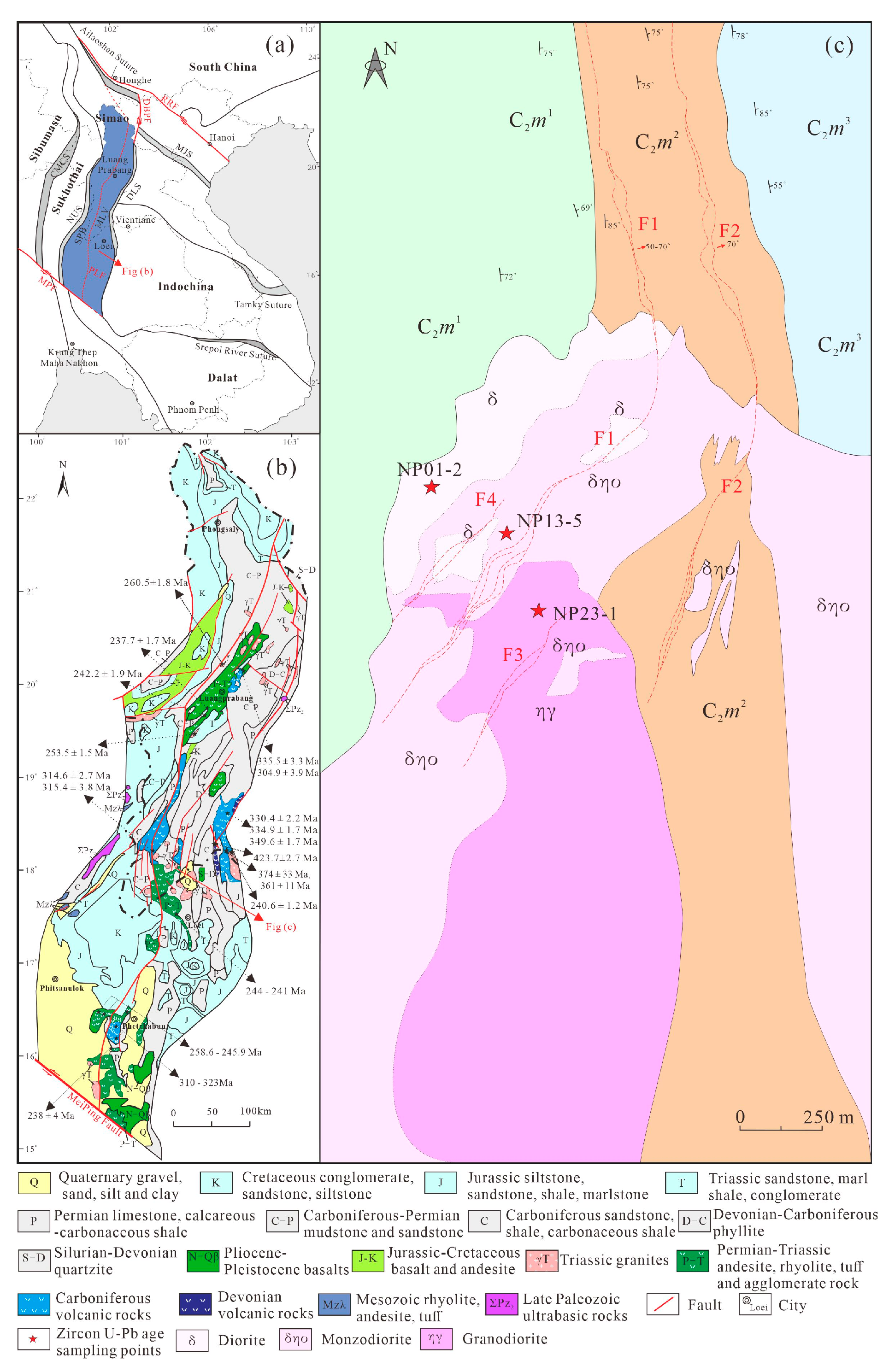
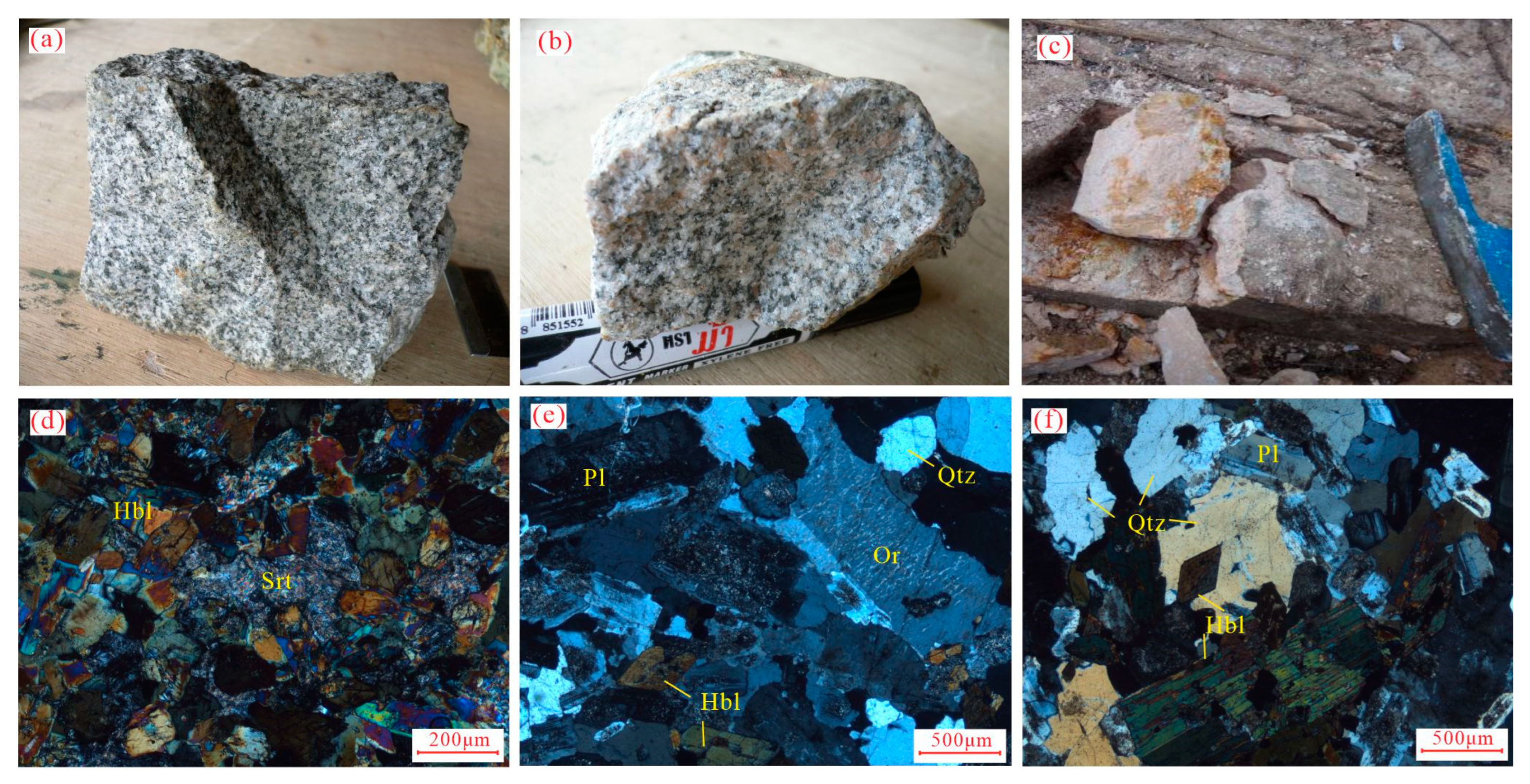



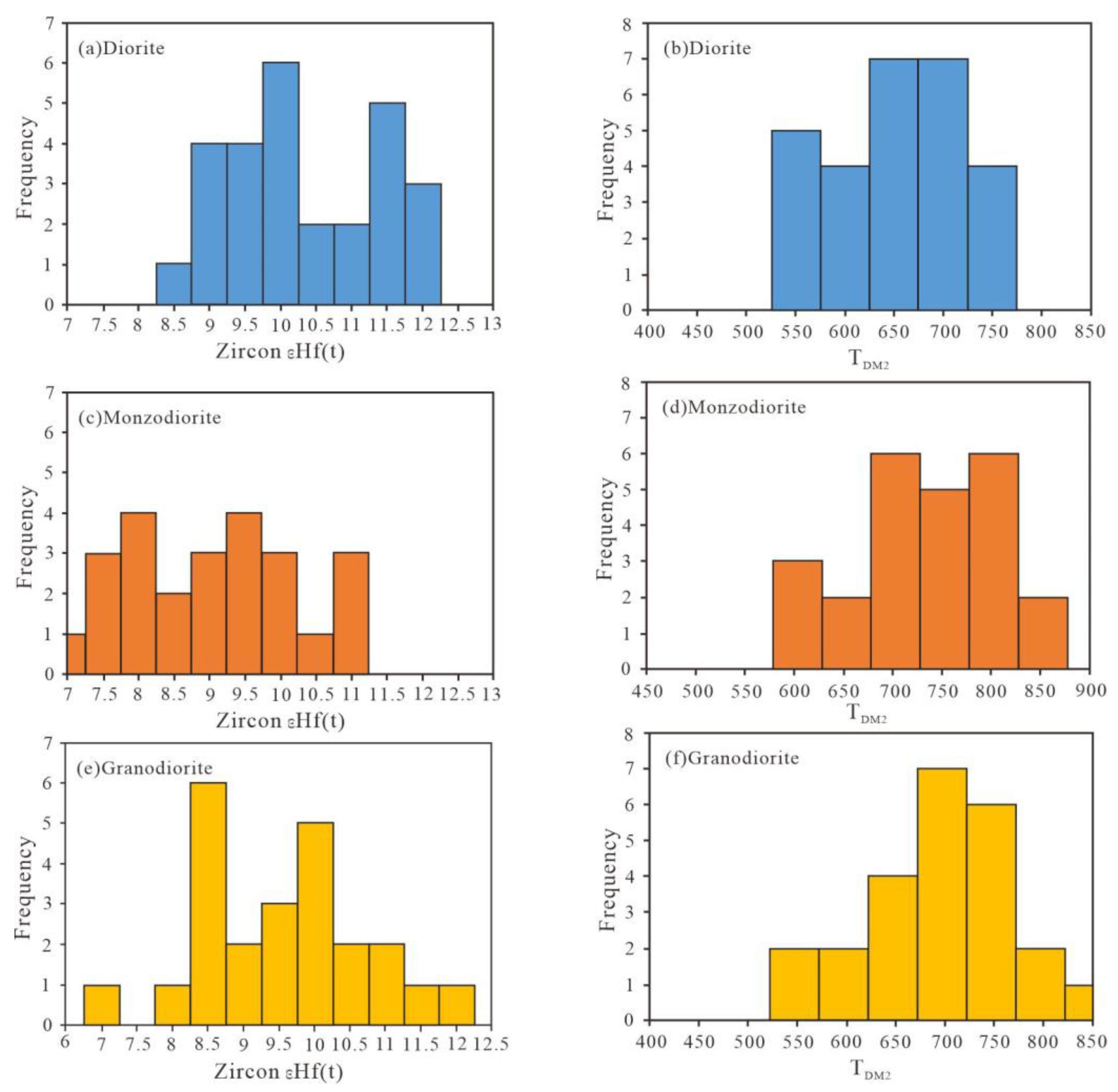
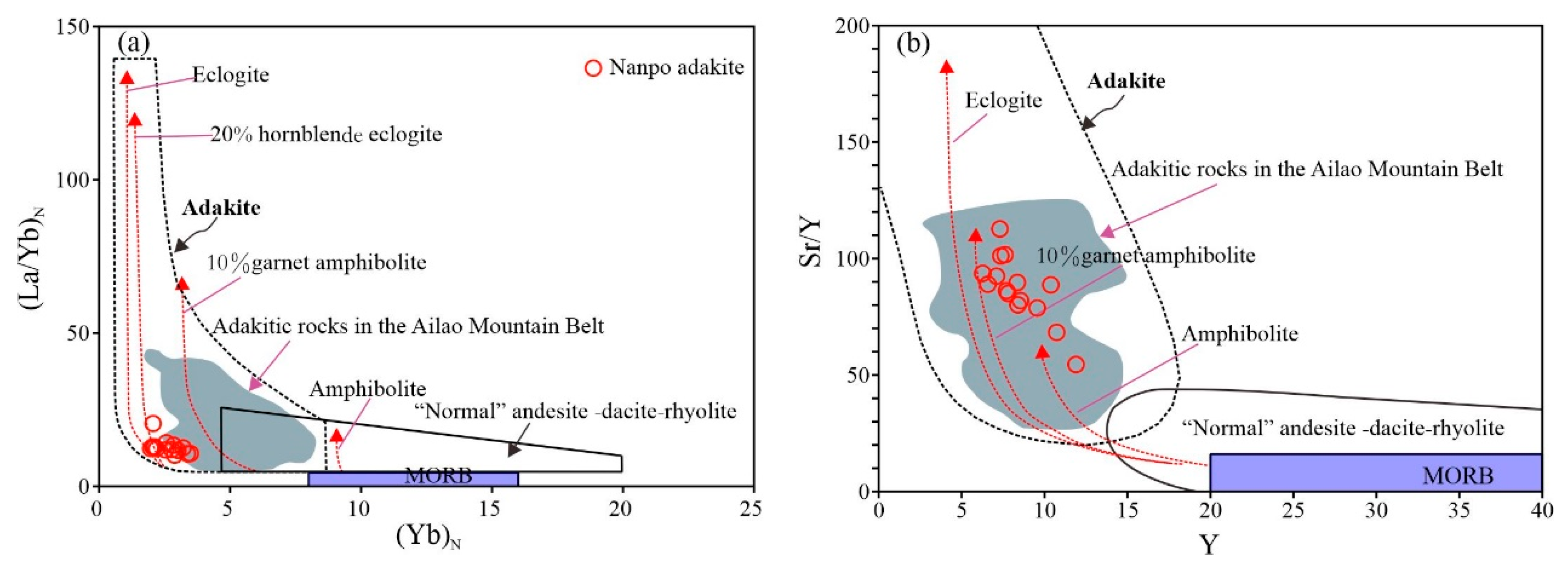

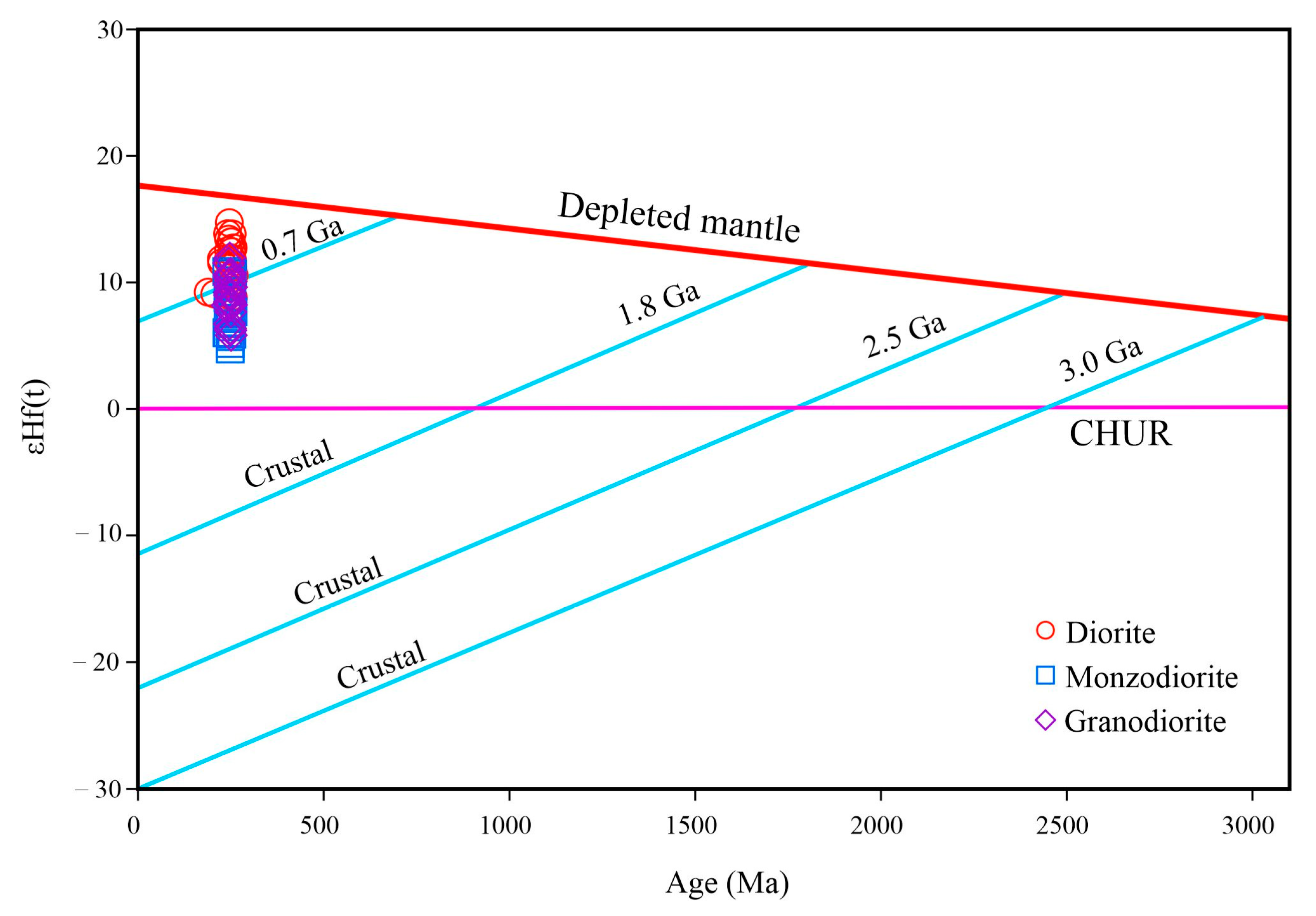
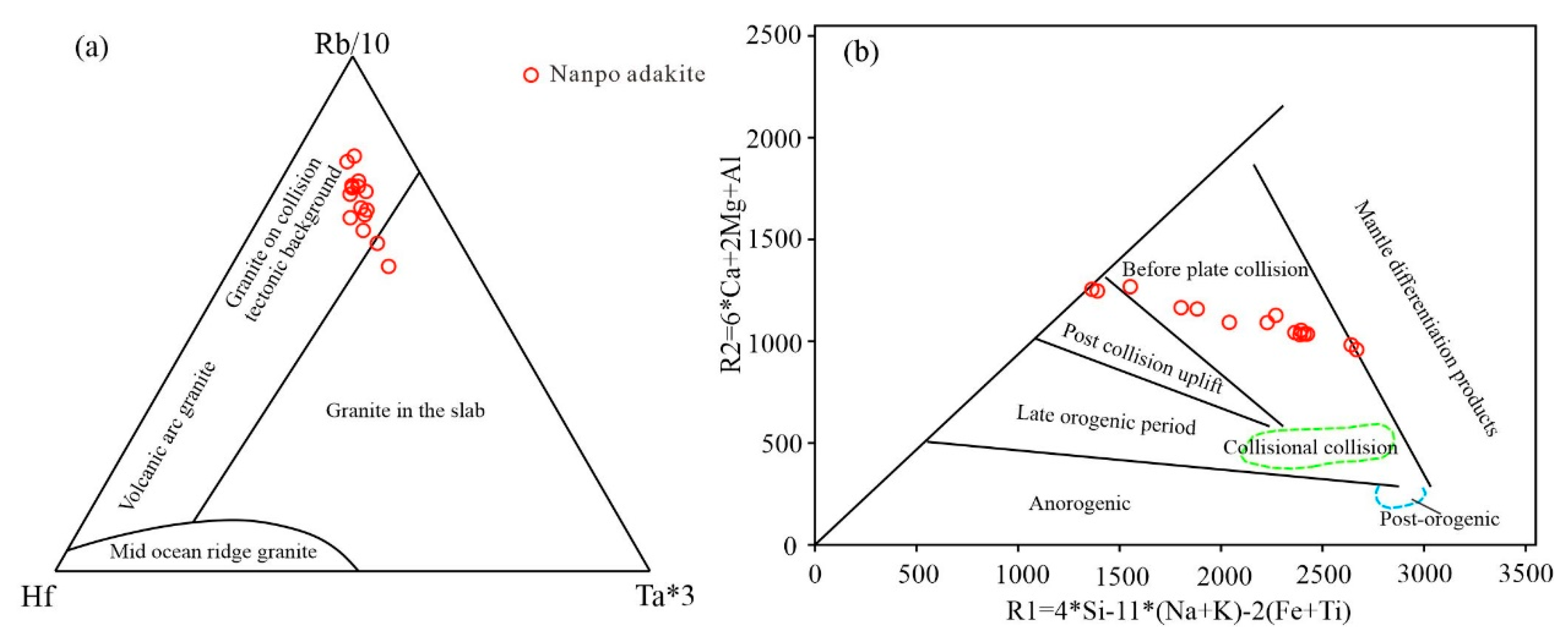

Disclaimer/Publisher’s Note: The statements, opinions and data contained in all publications are solely those of the individual author(s) and contributor(s) and not of MDPI and/or the editor(s). MDPI and/or the editor(s) disclaim responsibility for any injury to people or property resulting from any ideas, methods, instructions or products referred to in the content. |
© 2023 by the authors. Licensee MDPI, Basel, Switzerland. This article is an open access article distributed under the terms and conditions of the Creative Commons Attribution (CC BY) license (https://creativecommons.org/licenses/by/4.0/).
Share and Cite
Li, H.; Gan, J.; He, Z.; Gan, Y.; Wang, B.; Li, Y.; Jiang, W. Petrogenesis and Geodynamic Significance of the Early Triassic Nanpo Adakitic Pluton of the Luang Prabang-Loei Tectonic Belt (Northwestern Laos) in the East Tethys Domain: Constraints from Zircon U-Pb-Hf Isotope Analyses and Whole-Rock Geochemistry. Minerals 2023, 13, 821. https://doi.org/10.3390/min13060821
Li H, Gan J, He Z, Gan Y, Wang B, Li Y, Jiang W. Petrogenesis and Geodynamic Significance of the Early Triassic Nanpo Adakitic Pluton of the Luang Prabang-Loei Tectonic Belt (Northwestern Laos) in the East Tethys Domain: Constraints from Zircon U-Pb-Hf Isotope Analyses and Whole-Rock Geochemistry. Minerals. 2023; 13(6):821. https://doi.org/10.3390/min13060821
Chicago/Turabian StyleLi, Hui, Jie Gan, Zhengwei He, Yu Gan, Bin Wang, Yong Li, and Wei Jiang. 2023. "Petrogenesis and Geodynamic Significance of the Early Triassic Nanpo Adakitic Pluton of the Luang Prabang-Loei Tectonic Belt (Northwestern Laos) in the East Tethys Domain: Constraints from Zircon U-Pb-Hf Isotope Analyses and Whole-Rock Geochemistry" Minerals 13, no. 6: 821. https://doi.org/10.3390/min13060821
APA StyleLi, H., Gan, J., He, Z., Gan, Y., Wang, B., Li, Y., & Jiang, W. (2023). Petrogenesis and Geodynamic Significance of the Early Triassic Nanpo Adakitic Pluton of the Luang Prabang-Loei Tectonic Belt (Northwestern Laos) in the East Tethys Domain: Constraints from Zircon U-Pb-Hf Isotope Analyses and Whole-Rock Geochemistry. Minerals, 13(6), 821. https://doi.org/10.3390/min13060821





